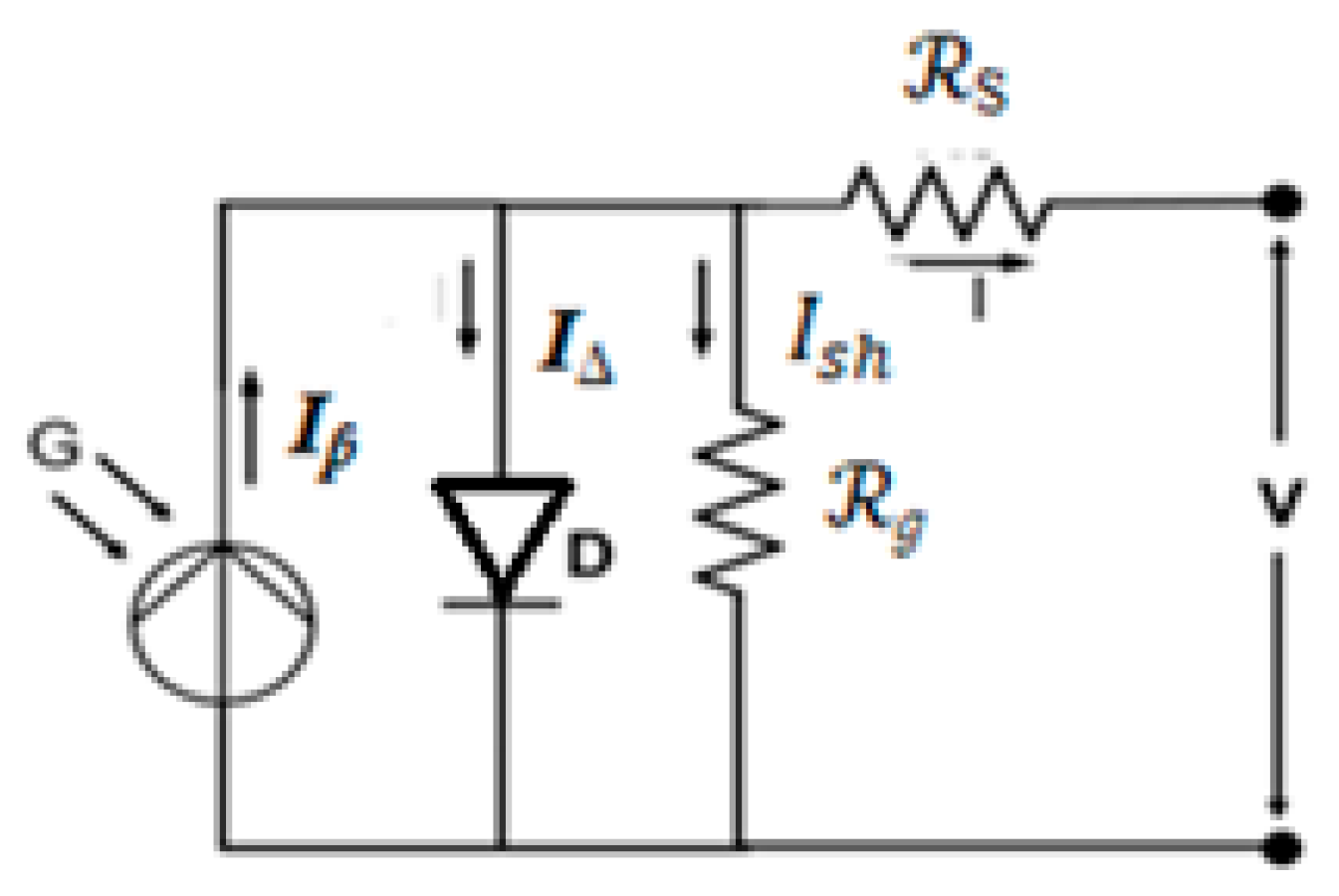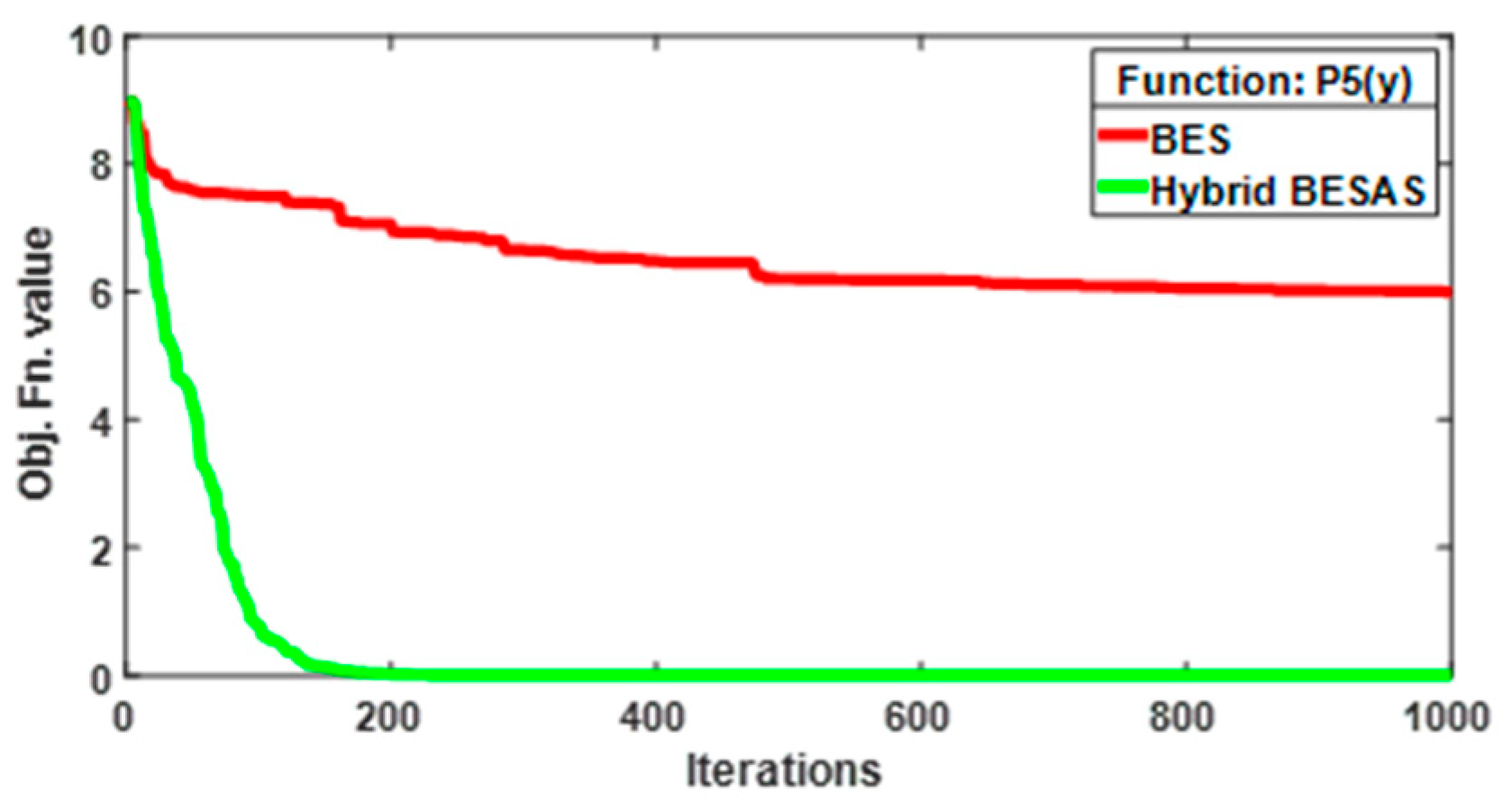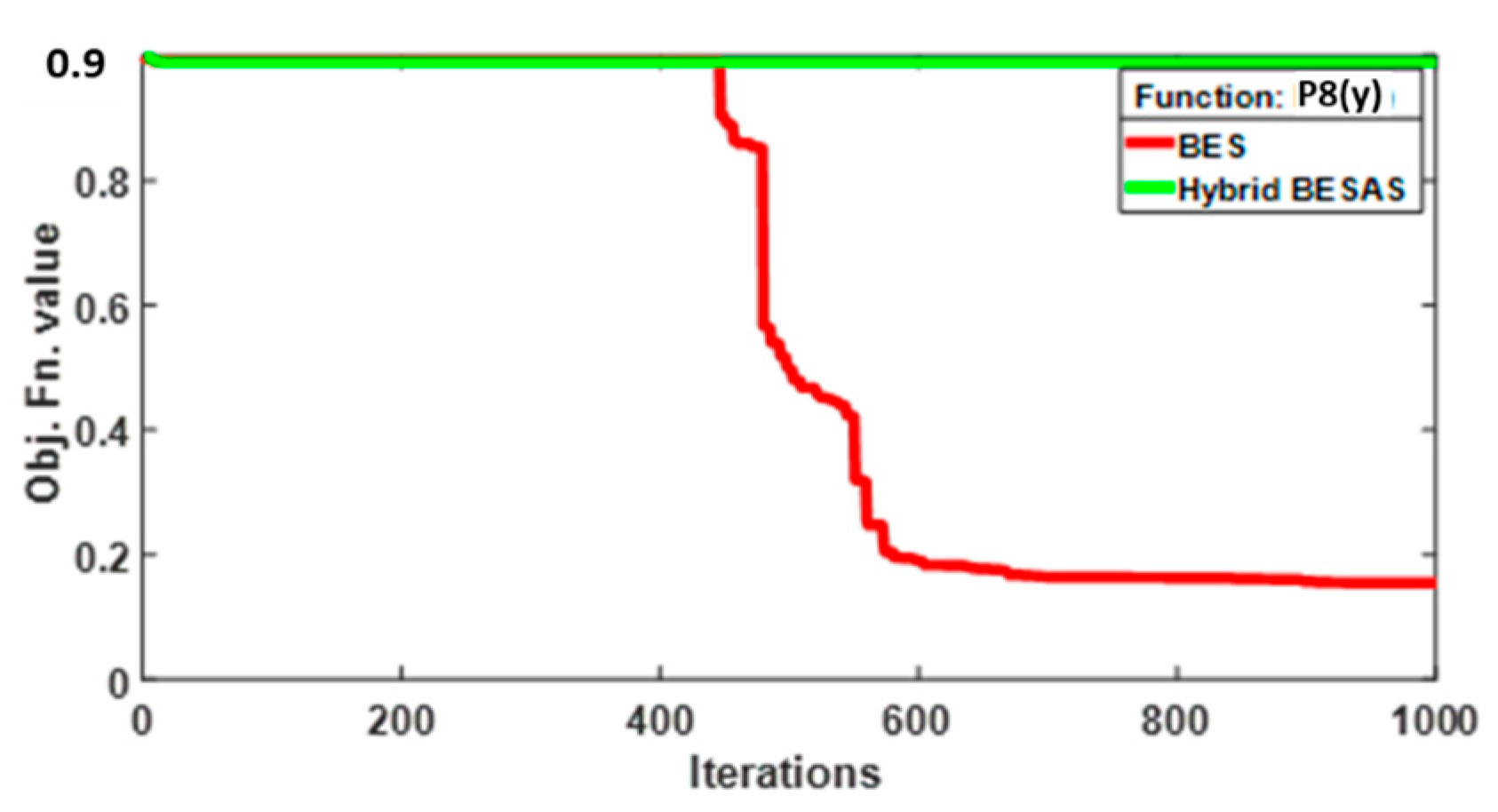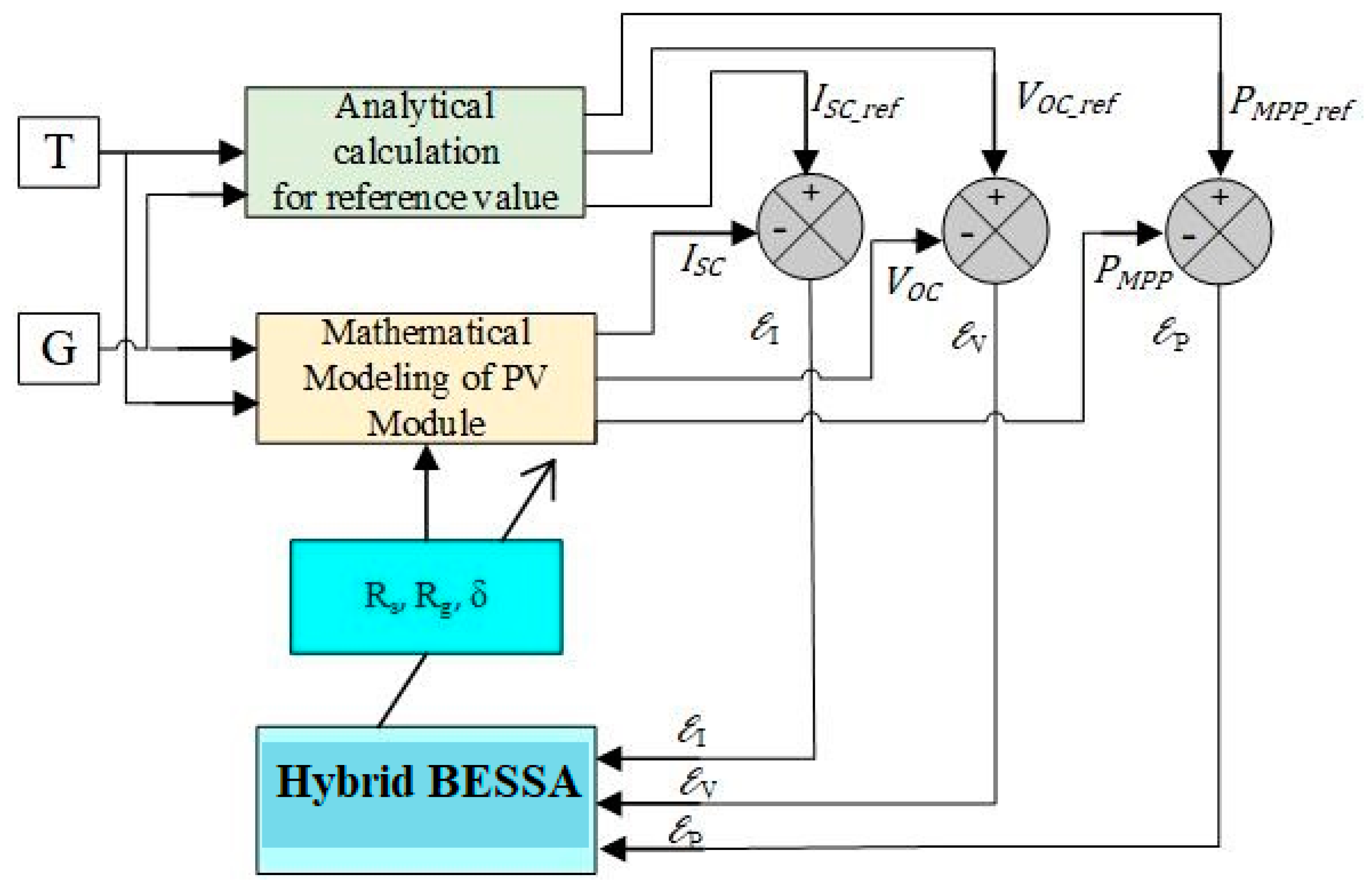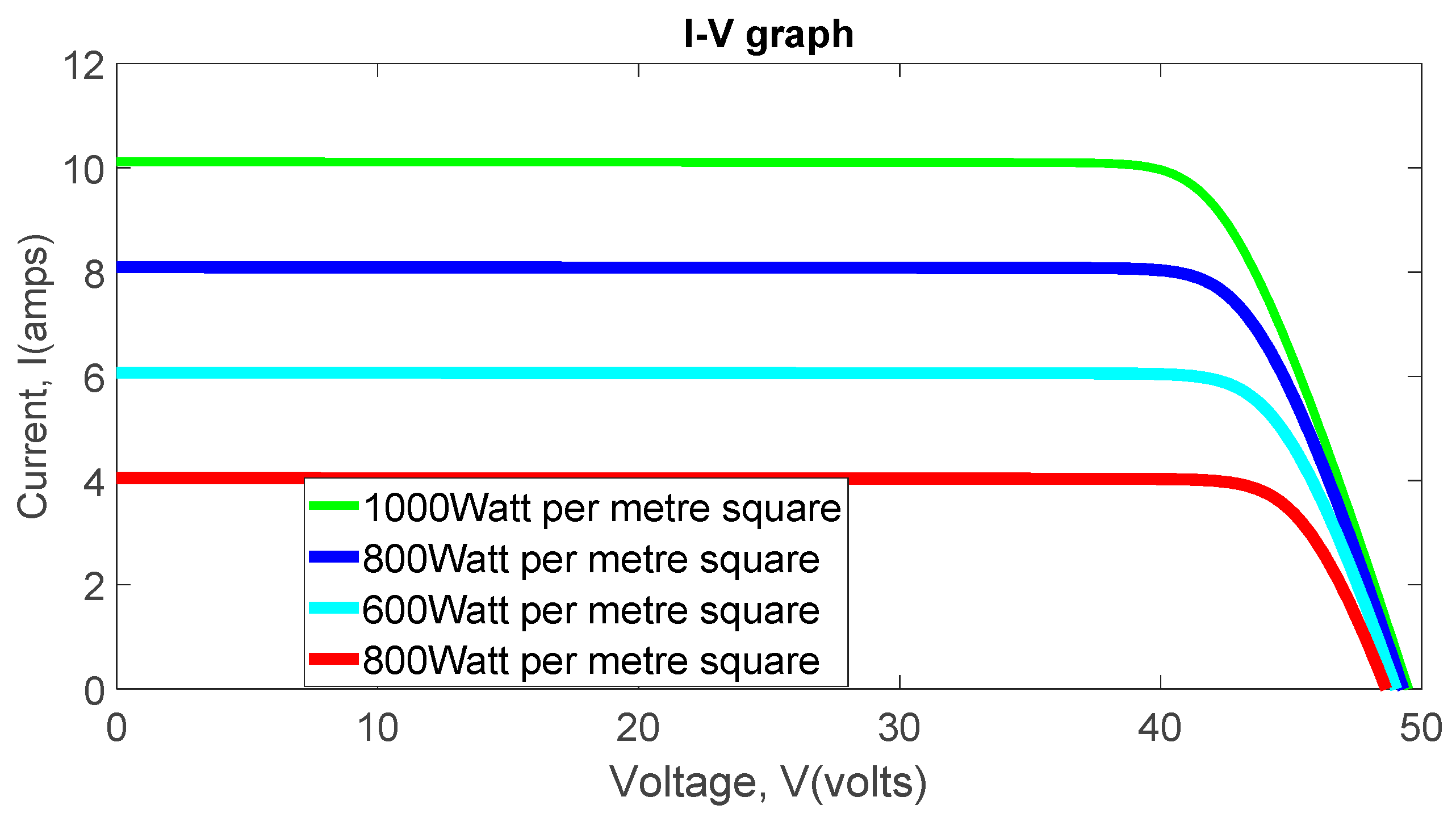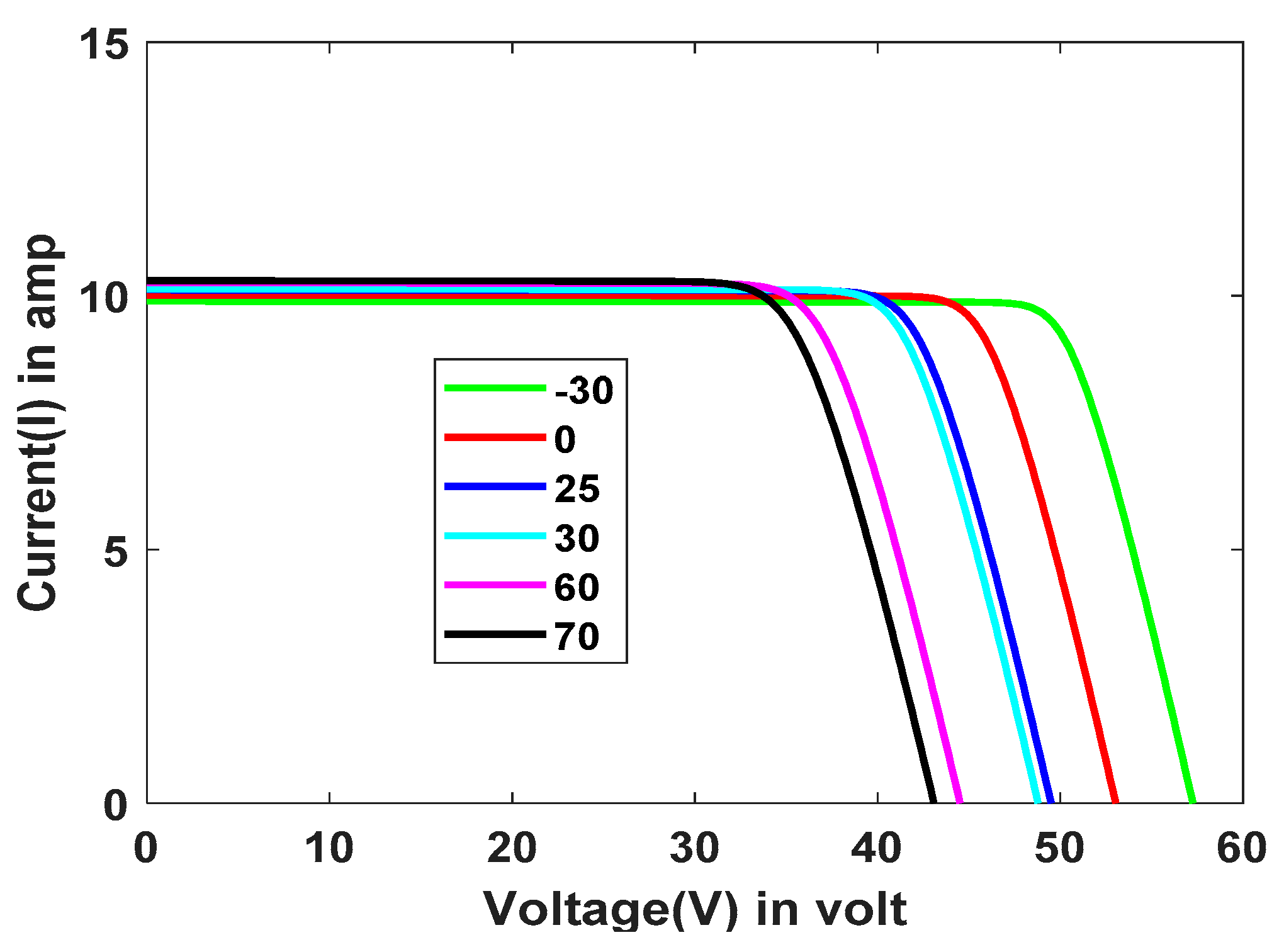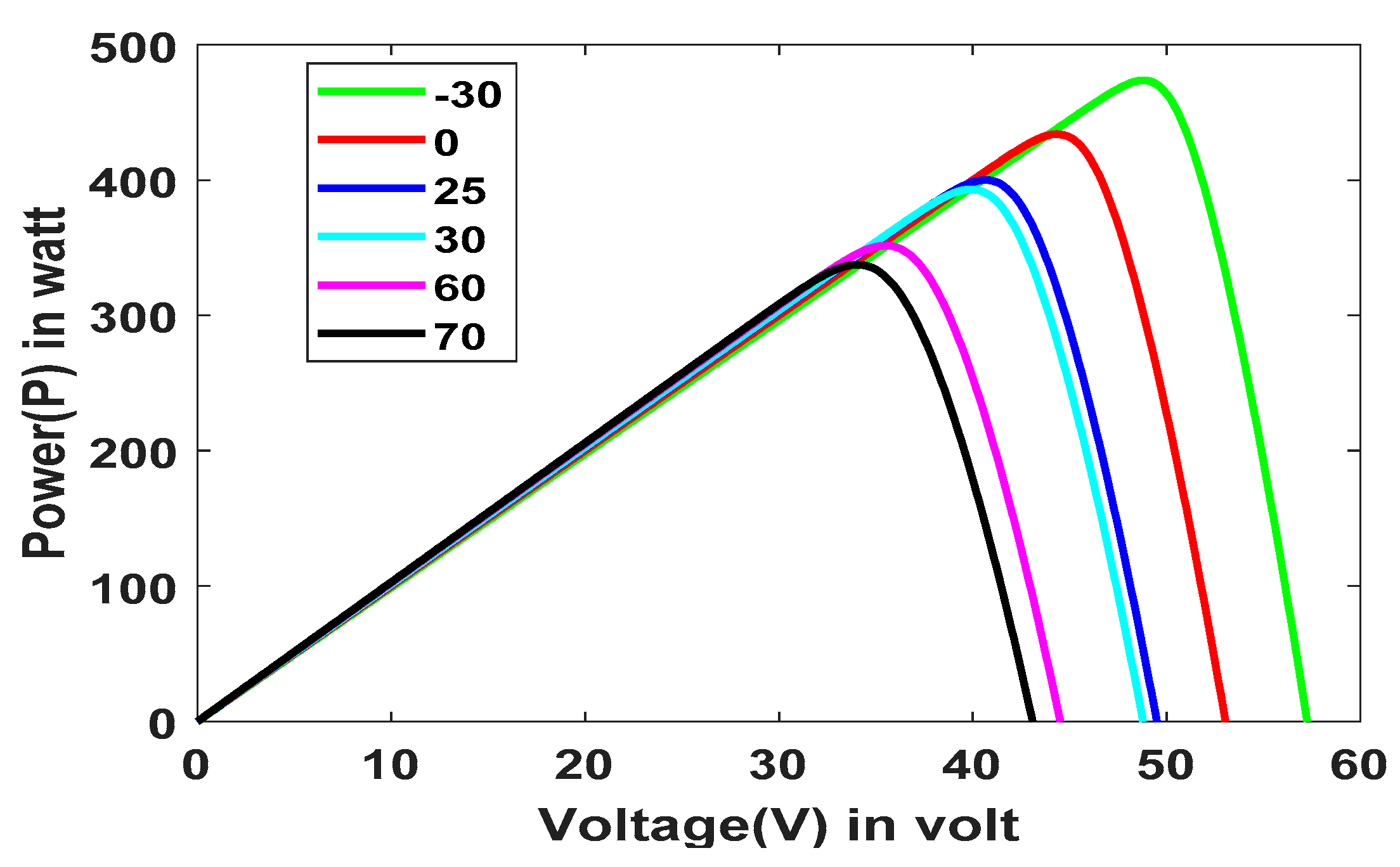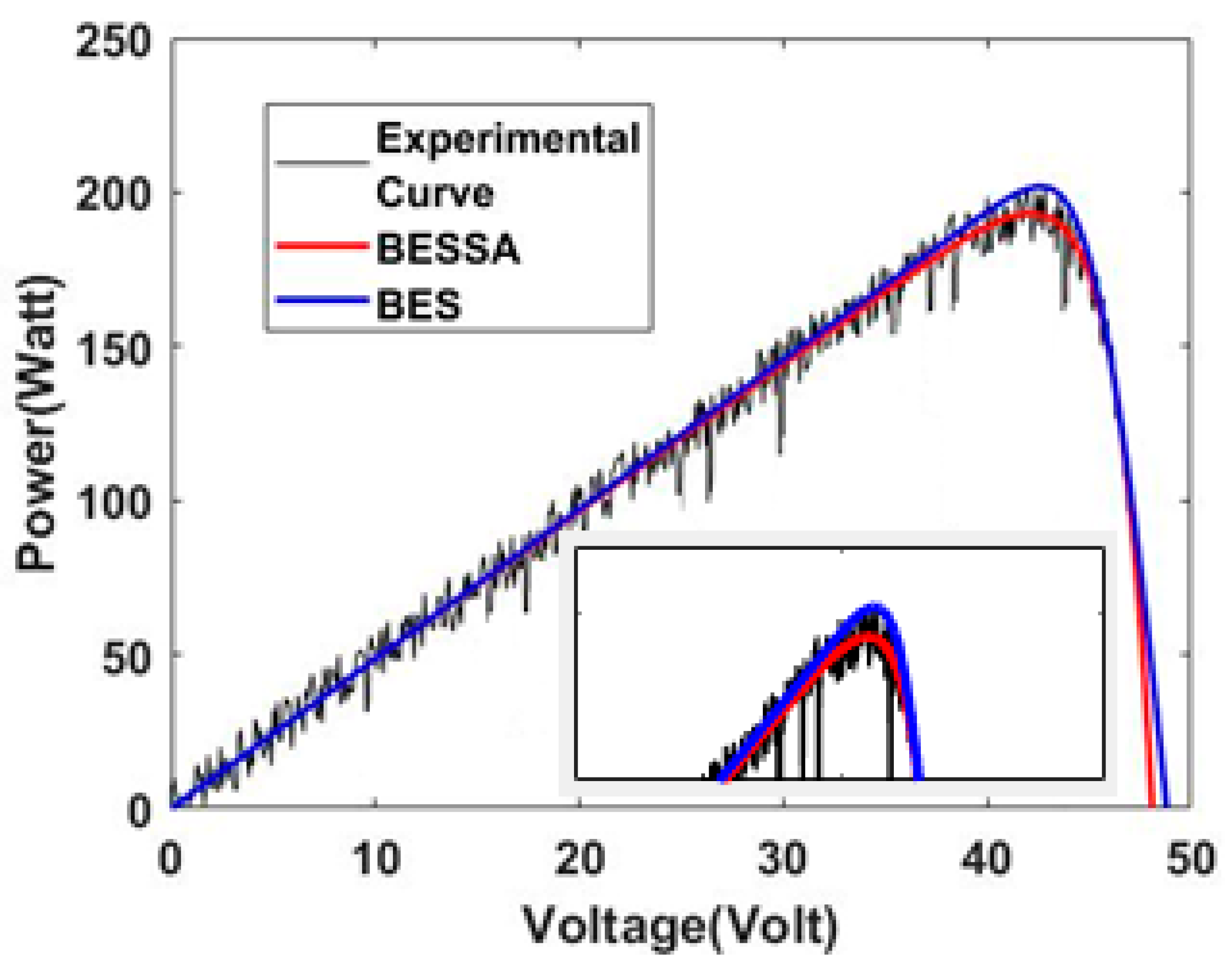1. Introduction
Predictive performance tools determine the success of any technology. Consumers can now obtain and analyze optimized performance evaluations of their PV modules. The high growth rate in the utilization of PV energy has led researchers to develop novel photovoltaic cells and to develop theoretical analyses for forecasting the performance estimation, sizing, and optimization of PV energy systems [
1]. In order to extract maximum power, the PV module must to be operated at its Maximum Power Point (MPP). This requires an MPP Tracker, which then demands a meticulous and accurate analytical model of PV cells for analysis and testing. A photovoltaic module operating at a temperature of 25 °C and irradiance of 1000 W/m
2 is said to be operating in Standard Operating Condition (SOC) [
2]. Again, it is well known that the manufacturer’s data sheet provides limited information regarding the operational data of a PV module [
2], as they only include PV module performance information operating in SOC. The data sheet provides information on short circuit current (ISC), open circuit voltage (VOC), maximum power (PMPP), voltage at PMPP (i.e., VMPP), and current at PMPP (i.e., IMPP) only when operating in SOC. In actuality, PV panels are subjected to operating conditions which differ from SOC. This requires a reliable PV model for apprehending electrical performance other than that achieved in SOC [
2].
It has been reported that PV modules can be modelled theoretically via many methods [
1]. It has also been reported that PV modelling based on two diode models is a mathematically rigorous and difficult process. As a result, the single-diode model has been adopted by most researchers worldwide for research and analysis [
3].
Without illumination, PV cells operate as diodes. When the PV cell is operated in illumination, it yields photocurrent. This leads the PV cell to be modelled in the form of a current source parallelly connected with a diode in series with resistance (
S) and in shunt to resistance(
ɡ) [
4]. The above-mentioned resistances model the dissipative effect and constructional defects, if any, that can cause a parasitic current.
Figure 1 shows the electrical equivalent of single-diode PV model incorporating its five parameters, i.e.,
ɡ,
δ,
S,
I∆, and
Iƥ. The PV cell performance is evaluated by visualizing it in the form of an electrical equivalent circuit including five parameters; these are
Iƥ,
I∆,
S,
ɡ, and
δ.
It is to be noted that the manufacturer’s datasheet does not provide information on these parameters. Hence, these parameters must be extracted using suitable techniques for the subsequent correct modelling and analysis of a PV module.
Researchers have detailed many techniques for the parameter extraction and modeling of PV modules. These include the Modified Gromov, Derivative α, and Simple Conductance [
5] methods, the penalty-based differential evolution algorithm [
6], the Newton–Raphson technique [
7], and using the Ant Lion Optimizer [
8].
Optimization algorithms [
9,
10] are an efficient method for finding solutions to many nonlinear real-world [
11,
12] problems. As the NFL (No Free Lunch) theory explains that one single optimization algorithm cannot provide satisfactory results for all types of problems, there is always the opportunity to discover and advance new optimization techniques that suit a particular problem [
13]. This is the motivation for this present research work.
Optimization techniques [
14,
15,
16,
17,
18,
19,
20,
21,
22,
23,
24,
25,
26,
27,
28,
29] are nature-inspired optimisation technique are broadly categorized into three categories. These are evolutionary methods, trajectory methods, and swarm methods [
14,
15,
16]. Alsattar et al. [
17] introduced Bald Eagle Search optimization technique. In 1983, Kirkpatrick [
18] developed Simulated Annealing technique to solve real world problem. Saha et al. implements optimization technique for parameter extraction of PV module. The performance efficiency of any optimization technique can be judged by applying on standard mathematical test functions [
20]. Many efficient optimization algorithm are proposed and tested by researcher such as Hybrid Water Cycle—Moth Flame Optimization algorithm (WCMFO) [
21], Artificial Bee Colony (ABC) algorithm [
22], Cuckoo Search (CS) [
23], Particle Swarm Optimization and Gravitational Search Algorithm (PSOGSA) [
24], Moth Flame Optimization (MFO) [
25], Gravitational Search Algorithm (GSA) [
26], Water Cycle Algorithm (WCA) [
27], Dragonfly Algorithm (DA) [
28], and Whale Optimization Algorithm (WOA) [
29] for finding solution to many real world problem.
Finding solution to problem based on multi-objective optimization process and single objective optimization process. It is found that multi-objective optimization process has better problem-solving ability as compared to single objective optimization process [
30].
Researchers all over the world suggest that [
16] there are three methods for improving optimization techniques. These are: (i) putting forward new optimization techniques, (ii) improving present techniques, and (iii) the hybridization of optimization techniques. The third one, hybridization of optimization techniques [
16], is one of the most popular and efficient methods. In this paper, a multi-objective PV module parameter extraction scheme depending upon the Hybrid Bald Eagle Search Simulated Annealing technique (Hybrid BESSA) is discussed. This technique is a hybridization of the Bald Eagle Search and Simulated Annealing techniques.
Problem-solving with a multi-objective optimization process has many advantages in comparison to solving problems with a single-objective problem formulation [
17]. It is reported in [
10] that multi-objective optimization can deal with many objectives at one time. Multi-objective optimization-solving schemes output better results when the objectives are correlated to each other as compared to a single-objective optimization problem-solving method. To reiterate, the single-objective optimization problem-solving method takes more time and is also a cumbersome process for finding the correct parameters, whereas a multi-objective optimization problem-solving method takes less time but is difficult to frame and requires a greater depth of optimization knowledge.
Section 2 focuses on the analytical modeling of the PV module.
Section 3 focuses on the BES technique.
Section 4 explains the Simulated Annealing technique.
Section 5 discusses the Hybrid BESSA technique and the improvement in the results obtained by implementing the Hybrid BESSA technique as compared to the BES for 23 benchmark functions.
Section 6 discusses a multi-objective parameter extraction scheme and problem formulation based on the Hybrid BESSA technique. Results are discussed in
Section 7. The conclusion and future scope for research are discussed in
Section 8.
6. Parameter-Setting of the Optimization Technique
The performance of any optimization algorithm builds upon the involved control parameters. Again, these parameters play a vital role in asserting an accurate solution. In the BESSA technique, the below parameters are considered. The position control parameter is 𝛇, and it varies from 1.5 to 2. The corner between the search is determined by parameter , which takes any value within a range of 5 to 10. The search cycle number is controlled by parameter , which takes any value between 0.5 and 2. In the swooping stage, the swing intensity of the bald eagle is increased by parameter m1, m2, which takes any value between 1 and 2. After generating an initial population with the BES technique, SA is implemented to reach the best solution. The solution which is a better fit is acceptable by a probability defined as a Boltzmann Probability(p). Here, θ determines degree of fit between the generated solution and the best solution. The temperature parameter is explained by T, which decreases in an organized way in accordance to the cooling scheme. The starting temperature is defined as 2 ∗ |N|. Here, N is the total number of attributes in the data set. In the tournament selection stage, the selection pressure is set at 0.5.
By nature, a metaheuristic algorithm is stochastic. The metaheuristic algorithm starts with a randomly generated initial population. The algorithm gradually proceeds and reaches the final stage depending on this initial population. Thus, multiple runs must be executed to derive the best, average, and standard values. To apprehend the performance appraisal of a metaheuristic algorithm, it is investigated with a number of benchmark test functions. In this work, the BESSA is tested on 23 benchmark functions [
20] which are used by researchers worldwide. These benchmark functions include multimodal functions, fixed dimensional multimodal functions, and unimodal functions. The exploitation capability of a metaheuristic optimization algorithm is investigated by testing it on unimodal functions, as these functions are characterized by possessing unique global optima but no local optima.
The multimodal functions and fixed dimensional multimodal functions are used for investigating the exploration capability of a metaheuristic optimization algorithm. The above functions are characterized by possessing unique global optima and many local optima. To determine the performance efficiency of the BESSA technique, a comparison was made with the recently proposed BES [
17] and CamWOA techniques [
9]. The Hybrid BESSA technique was also compared with the Hybrid Water Cycle—Moth Flame Optimization algorithm (WCMFO) [
21], Artificial Bee Colony (ABC) algorithm [
22], Cuckoo Search (CS) [
23], Particle Swarm Optimization and Gravitational Search Algorithm (PSOGSA) [
24], Moth Flame Optimization (MFO) [
25], Gravitational Search Algorithm (GSA) [
26], Water Cycle Algorithm (WCA) [
27], Dragonfly Algorithm (DA) [
28], and Whale Optimization Algorithm (WOA) [
29], as described in the literature [
9]. The mentioned algorithms’ control parameters are detailed in the
Appendix A.
For all the above analyses, the maximum number of search particles taken and the total iteration counts were limited to 100 and 1000, respectively, which are common parameters for all the algorithms mentioned above. To reach the right conclusion, the number of runs for each algorithm was fixed at 30. The residuum is analyzed in following section.
Fan et al. [
32] developed a random reselection PSO for the optimal design of solar PV modules. There are different optimization models which have been developed to handle the model parameters of PV solar panels [
33,
34,
35,
36,
37,
38,
39,
40,
41], which include the mutation-based PSO, slime mold algorithm, Gorilla Troops optimizer, Harris Hawk technique, gradient-based optimizer, and Coyote optimization technique. The application of such metaheuristic techniques has also been observed in crack detection for cantilever beams [
42].
Analysis and Appraisal of Exploitation Capability (–)
The unimodal functions ascertain and evaluate the exploitation capability of an optimization technique. These unimodal functions are tabulated in
Table 1.
To appraise the exploitation capability of the proposed BESSA Technique, it is tested on seven unimodal functions, i.e.,
, as presented in [
9]. The results are depicted in
Table 2. These unimodal functions are characterized by having single global optima. The statistical outcomes of the BESSA, original BES, CamWOA, and the other 10 algorithms presented in [
9] are also tabulated. It was observed that the Hybrid BESSA produced better results and was able to find global optima for all of the unimodal functions as compared to the BES, CamWOA, and other techniques mentioned in [
9].
Appraisal and Analysis of Exploration Capability (p8(y)–p13(y))
Multimodal functions are characterized by having a number of local optima, thus testing on these functions appraise the exploration capability of any metaheuristic algorithm.
Table 3 lists the multimodal functions.
Table 4 enumerates the statistical results of the different algorithms gathered for 30 runs on every benchmark function.
The statistical outcomes of the Hybrid BESSA, BES, CamWOA, and the other ten optimization techniques [
9] tested on the multimodal functions (
), are reported in
Table 4, and it was found that the Hybrid BESSA technique produced better results for all of the mentioned functions except function
.
For function , the BES produced a better result than the Hybrid BESSA orsCamWOA. For function , the results are comparable.
Appraisal and Analysis of Exploration Capability (Testing on Fixed Dimension Multimodal Functions, f14(p) − f23(p))
The fixed dimensional multimodal functions (
and their outcomes are displayed in
Table 5 and
Table 6. It was found that, when tested upon the fixed dimensional multimodal functions (
), the proposed Hybrid BESSA technique and the BES were both able to find global optima for functions
. For functions
,
,
,
, and
, the Hybrid BESSA produced better results than the BES, CamWOA, and all of the other mentioned 10 optimization techniques [
9]. For functions
and
, the proposed BESSA was able to find global optima. For functions
,
, and
, CamWOA provided better results. From the above analysis, it is evident that the Hybrid BESSA has a better exploration capability when compared to the BES, CamWOA, and other techniques.
Examining all of the above analysis for the unimodal functions, multimodal functions, and fixed dimensional multimodal functions, the proposed Hybrid BESSA produced better results for 19 out of the 23 functions. Hence, the proposed BESSA technique was proved to be a more efficient technique compared to the BES [
17], CaMWOA [
9], ABC [
23], CS [
24], GSA [
27], PSOGSA [
25], WCA [
28], MFO [
26], DA [
29], and WCMFO [
22] as detailed in [
9].
Convergence Characteristics Analysis
Convergence characteristics play a vital role, as they offer information about how population-based optimization search techniques converge to a best solution. It is seen from the
Figure 3,
Figure 4,
Figure 5,
Figure 6,
Figure 7 and
Figure 8 that the proposed Hybrid BESSA has better convergence characteristics compared to the BES.
9. Discussion
A multi-objective parameter extraction scheme based on the Hybrid BESSA and BES for PV modules is discussed in this work. In the first stage, the efficacy of the Hybrid BESSA was analyzed with testing on unimodal benchmark functions, fixed dimensional benchmark functions, and fixed dimensional multimodal benchmark functions, as discussed in
Section 6. The statistical results of the Hybrid BESSA technique was compared with those of the BES, Hybrid Water Cycle—Moth Flame Optimization Algorithm (WCMFO) [
21], Artificial Bee Colony (ABC) algorithm [
22], Cuckoo Search (CS) [
23], Particle Swarm Optimization and Gravitational Search Algorithm (PSOGSA) [
24], Moth Flame Optimization (MFO) [
25], Gravitational Search Algorithm (GSA) [
26], Water Cycle Algorithm (WCA) [
27], Dragonfly Algorithm (DA) [
28], and Whale Optimization Algorithm(WOA) [
29] as detailed in [
9]. For all of the above analyses, the maximum number of search particles taken and total iteration counts were limited to 100 and 1000, respectively, and these are common parameters for all of the algorithms mentioned above. To reach the right conclusion, the number of runs for each algorithm was fixed at 30.
It was observed that the Hybrid BESSA produced better results and was able to find global optima for all of the unimodal functions when compared to the BES, CamWOA, and all of the other above-mentioned techniques [
9]. The statistical outcomes from the Hybrid BESSA technique obtained by testing multimodal functions revealed that the Hybrid BESSA technique produced better results for all of the mentioned functions except function
. For function
, the BES produced better results than the Hybrid BESSA and CamWOA. For function
, the results were comparable.
When tested upon the fixed dimensional multimodal functions, it was found that the Hybrid BESSA and BES techniques were both able to find global optima for functions
. For functions
,
,
,
, and
, the Hybrid BESSA produced better results than the BES, CamWOA, and all of the other mentioned 10 optimization techniques [
9]. For functions
and
, the proposed BESSA was able to find global optima. For functions
,
, and
, CamWOA provided better results. From the above analysis, it is evident that the Hybrid BESSA has a better exploration capability when compared to the BES, CamWOA, and other techniques.
Thus, it was concluded that the Hybrid BESSA has better exploration and exploitation capabilities when compared to the BES, CamWOA, WCMFO, ABC, CS, PSOGSA, MFO, GSA, WCA, DA, and WOA.
Again, by studying the convergence characteristics in
Section 6, it was found that the convergence capability of the Hybrid BESSA was better and faster than that of the BES. This is due to the hybridization of a global search (i.e., BES) with local search (i.e., SA) techniques.
The Hybrid BESSA was also used for parameter extraction for the PV Module AS-M3607-S in a MATLAB/SIMULINK environment.
It was found that single-diode PV modeling based on parameters extracted from the Hybrid BESSA was more robust and accurate than that based on the BES-based extracted parameters. The efficacy of the modeling was tested in two ways. The first was by varying temperature from−30 °C to 0 °C, 25 °C, 30 °C, 50 °C, and 70 °C while keeping irradiance fixed at 1000 W/m2. In the second set of tests, the temperature was kept fixed at 25 °C and the irradiance varied by four values, i.e., 400 W/m2, 600 W/m2, 800 W/m2, and 1000 W/m2.
For exactness and efficacy in evaluation, the lower bound and upper bound of the extracted parameters are specified in
Table 7.
Table 8 provide the values of the parameters extracted using the Hybrid BESSA and BES techniques for the PV Module AS-M3607-S (G1 CELLS) when keeping irradiance fixed at 1000 W/m
2 and varying temperature from −30 °C to 70 °C.
Table 10 provides the parameters extracted by applying the Hybrid BESSA and BES techniques to the PV Module AS-M3607-S (G1 CELLS) when keeping temperature fixed at 25 °C and varying irradiance from 1000 W/m
2 to 800 W/m
2, 600 W/m
2, and 400 W/m
2.
Table 9 and
Table 11 provide information about the reference values for power, current, and voltage, as well as the percentage error for the open circuit voltage, percentage error of power, and percentage error for the short circuit current of the PV Module AS-M3607-S when simulated using parameters extracted with the Hybrid BESSA and BES techniques, respectively, at different temperatures while keeping irradiance fixed at 1000 W/m
2.
It can be seen from
Table 9 that when the modeling of the PV cell was conducted with the Hybrid BESSA-based extracted parameters with irradiance at 1000 W/m
2 and temperature at −30 °C, the combined objective function (Y) obtained was 3.6199 × 10
5 and the percentage error for the open circuit voltage (
), percentage error of power(
), and percentage error for the short circuit current (
)were 0.703, 0, and 0.01, respectively, whereas when the parameters extracted from the Hybrid BESSA resulted in a combined objective function of 3.654 × 10
5, the obtained values for
,
, and
were 1.49, 0.201, and 0, respectively. The improvement in the combined objective function using the Hybrid BESSA-based extraction technique was 0.9
as compared to that of the BES.
When irradiance was fixed at 1000 W/m2 with a temperature of 0 °C, the corresponding values of Y, , , and were 2.73 × 105, 0, 0.378, and 0, respectively, for the modeling conducted with the Hybrid BESSA-based extracted parameters, whereas those same values were 298,578.7, 0.161, 0.738, and 0, respectively, for the modeling conducted with the BES-based extracted parameters. The improvement in the combined objective function using the Hybrid BESSA-based extraction technique was 8.5 as compared to that of the BES.
When irradiance was fixed at 1000 W/m2 with a temperature of 25 °C, the corresponding values of Y, , , and were 2.12 × 105, 0, 0, and 0 for the modeling conducted with the Hybrid BESSA-based extracted parameters, whereas those same values were 298,578.7, 0.025, 0, 0, and 0 for the modeling conducted with the BES-based extracted parameters. The improvement in the combined objective function using the Hybrid BESSA-based extraction technique was 29.2 as compared tothat of the BES.
When irradiance was fixed at 1000 W/m2 with a temperature of 30 °C, the corresponding values of Y, , , and were 2.01 × 105, 0, 0.081, and 0 for the modeling conducted with the Hybrid BESSA-based extracted parameters, whereas those same values were 200,937.4, 0.204, 0.101, and 0 for the modeling conducted with the BES-based extracted parameters. The improvement in the combined objective function using the Hybrid BESSA-based extraction technique was 0.03 as compared to that of the BES.
When irradiance was fixed at 1000 W/m2 with a temperature of 50 °C, the corresponding values of Y, , , and were 1.61 × 105, 0, 0.476, and 0 for the modeling conducted with the Hybrid BESSA-based extracted parameters, whereas those same values were170,735.5, 0.101, 0.204, and 0 for the modeling conducted with the BES-based extracted parameters. The improvement in the combined objective function using the Hybrid BESSA-based extraction technique was 5.7 as compared to that of the BES.
When irradiance was fixed at 1000 W/m2 with a temperature of 70 °C, the corresponding values of Y, , , and were 1.26 × 105, 0, 0.101, and 0 for the modeling conducted with the Hybrid BESSA-based extracted parameters, whereas those same values were 126,727.9, 0.088, 1.21, and 0 for the modeling conducted with the BES-based extracted parameters. The improvement in the combined objective function using the Hybrid BESSA-based extraction technique was 0.5 as compared to that of the BES.
It can be seen from
Table 11 that when the modeling of the PV cell was conducted with the Hybrid BESSA-based extracted parameters with irradiance at 1000 W/m
2 and a temperature of 25 °C, the combined objective function(Y) obtained was 2.108 × 10
5, and the percentage error for the open circuit voltage (
), percentage error of power (
), and percentage error for the short circuit current (
)were 0, 0.01, and 0, respectively, whereas the parameters extracted using the Hybrid BESSA resulted in a combined objective function 211,863.1 and the
,
, and
obtained were 0, 0.26, and 0, respectively. The improvement in the combined objective function using the Hybrid BESSA-based extraction technique was 0.5
as compared to that of the BES.
When temperature was fixed at 25 °C with irradiance at 800 W/m2, the corresponding values of Y, , , and were 1.3425 × 105, 0, 0.424, 0.1 for the modeling conducted with the Hybrid BESSA-based extracted parameters, whereas they were 146,235.2, 0.1869, 0.612, and 0.1 for the modeling conducted with the BES-based extracted parameters. The improvement in the combined objective function using the Hybrid BESSA-based extraction technique was 8.1 as compared to that of the BES.
When temperature was fixed at 25 °C with irradiance at 600 W/m2, the corresponding values of Y, , , and were 7.64534 × 104, 0, 0.969, and 0.01 for the modeling conducted with the Hybrid BESSA-based extracted parameters, whereas they were 76,846.52, 0.310, 1.87, and 0 for the modeling conducted with the BES-based extracted parameters. The improvement in the combined objective function using the Hybrid BESSA-based extraction technique was 0.5 as compared to that of the BES.
When temperature was fixed at 25 °C with irradiance at 400 W/m2, the corresponding values of Y, , , and were 3.4316 × 104, 0, 2, and 0.01 for the modeling conducted with the Hybrid BESSA-based extracted parameters, whereas they were 34,623.14, 0.81, 2.018, and 0.01 for the modeling conducted with the BES-based extracted parameters. The improvement in the combined objective function using the Hybrid BESSA-based extraction technique was 0.8 as compared to that of the BES.
From the above analysis, it is evident that the combined objective function of , , and demonstrated significant improvements in the PV cell modeling conducted with the Hybrid BESSA-based extracted parameters as compared to the BES-based extracted parameters. This proves the robustness and high accuracy of the Hybrid BESSA technique.
The modeling was simulated based on the practical hardware PV Module AS-M3607-S. The multi-objective parameter extraction scheme based on the Hybrid BESSA provided a more accurate modeling output as compared to that of the BES. This is evident from the lower percentage error of power, lower percentage error of the open circuit voltage, and lower percentage error of the short circuit current. The percentage error was calculated by comparing the results with the respective reference values. The combined objective function was also found to be lower for the Hybrid BESSA-based multi-objective parameter extraction technique as compared to that of the BES.
The PV modeling output obtained using the multi-objective parameter extraction scheme based on the Hybrid BESSA and the BES was also tested on a hardware platform using ARDUINO boards, as depicted in
Figure 13. It is evident from
Figure 15 that the PV curve simulated using the parameters extracted via the multi-objective parameter extraction scheme based on the Hybrid BESSA was a better fit to the hardware-obtained results as compared to those of the BES. The PV Module AS-M3607-S was the basis for both the simulation and hardware results.
